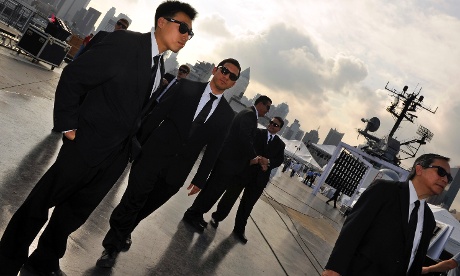
To most, the premise on which the Men in Black films are based may seem pleasingly fanciful; but not to all. Quite a lot of people believe that dark-suited gents are indeed policing contact between aliens and humans. Concern about this activity goes back a long way. The first of the films, which appeared in 1997, was based on a relatively obscure black-and-white comic-book . This had been launched in 1990, but even by then, speculation about a corps of black-clothed figures supposedly managing our relationship with extraterrestrials was already decades old.
In 1953, Albert K Bender, the editor of a UFO publication called Space Review, announced that he'd found the solution to the flying saucer mystery but had been forbidden to print it. He warned others working in the field to be cautious, and then stopped publishing. Later he said that three men wearing dark suits had told him to write no more about UFOs, and he'd obeyed them because he'd been "scared to death".
Thereafter, other people who'd been present at putative UFO encounters also reported approaches from black-suited figures who tried to enforce their silence. These characters resorted to psychological pressure when necessary and, if that failed, to physical harm. Some of the people who were approached assumed that their callers were representatives of a secret government agency, like the one featured in Men in Black 3. Sometimes, however, there were indications that the troubling visitants might themselves be aliens.
Something about them was often not quite right. They walked with an odd limp, spoke in monotone or were deathly pallid. Their brand-new limousine was actually a long discontinued model. They failed to recognise common objects like ball-point pens. Their dark glasses appeared to hide unnaturally glowing eyes. Of course, we should treat with caution the accounts of people who claimed to have recently seen a flying saucer. They're bound to have been in a somewhat excitable state.
It's even been suggested that the so-called men-in-black may actually themselves be slightly unhinged ufologists — "Walter Mitty types", as a former head of the MoD UFO desk reportedly described them. However, "UFO silencers" were being recorded long before alien visitation had become a basement-dwellers' obsession. Mysterious figures were said to have mopped up evidence of apparent extraterrestrial encounters in 1864, 1897 and 1898 .
Today, scores of eye-witness accounts have accumulated , and just occasionally, physical evidence has been brought forward as well. In the late 1960s, there was a clutch of UFO sightings along America's east coast. A contributor to New York's Saucer News called Jack Robinson collated many of these. Subsequently, his wife reported that their home in Jersey City was being watched from a doorway by a strange, pale-faced man "dressed all in black with a black hat and a black suit on". A UFO expert called Timothy Beckley turned up and took a photo of this apparition. At that, the figure disappeared, but this supposedly is the snap.
Oddly, the fellow in the picture sports neither black suit nor black hat, but perhaps this disguise doesn't register on film stock. A sketch made by Albert K Bender offers a more orthodox if less intriguing portrait; but, guess what, video images have now become available. After a Maryland UFO sighting, two suspicious-looking black-clad figures with hypnotic eyes were captured on CCTV in a hotel lobby.
It has to be acknowledged that all of this testimony is somewhat less than conclusive, while even those who are convinced that men-in-black exist are rarely sure of their provenance. Bender came to believe that the visitors who silenced him were aliens from a planet called Kazik. On the other hand, conspiracist saucerians hold that the MiB are Earthly enforcers working on behalf of international banking interests to block the technological progress and moral reform that aliens are trying to bestow on us. Spoilsports dare to suggest that hoaxers may have polluted some of the data.
All the same, there's definitely something about those black-garbed guys. Beckley speculated that characters from folklore like the Elizabethan Black Men, the native American Black Man and the malevolent travelling salesmen of legend may all have been manifestations of what we now think of as men-in-black. Be that as it may, charcoal-clad chaps have long proved capable of casting a scary spell.
The look has been seized on by groups eager to intimidate ranging from the Jesuits to American supreme court judges and Man United's hooligans. In a book entitled Men in Black, John Harvey traces a growing enthusiasm for black attire on the part of men intent on inspiring awe going back 1,000 years and leaping remorselessly from church to court and from court to trade. By the 19th century it had become the sole garb of masculine wealth and power, a phenomenon about which Dickens, Ruskin and Baudelaire all expressed puzzlement.
In Reservoir Dogs, Mr Pink enquires: "Why can't we pick our own colours?" Joe replies: "No way, no way. Tried it once; doesn't work. You got four guys all fighting over who's gonna be Mr Black." But why?

